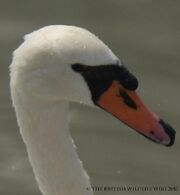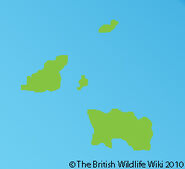The Mute Swan (Cygnus olor) uses its long neck to search for molluscs under plants. These make up most of

Head of an Adult Mute Swan - WWC Archives
its diet but can be supplemented with worms and some insects. If they accidently suck in any gravel, it counts as roughage. Mute swans pair during the autumn when they are around two to four years old. Mute swans stay with the same mate for life unless they fail they to breed. The find an isolated spot in where to nest. The nest is very large, it can measure up to four metres in diameter. It composes of a mound of water-plants and mud. The male becomes very aggessive during the breeding season, and is also very territorial. Eggs are laid on alternate days for up to two weeks during April and July. It is the female who mainly incubates them. They hatch about thirty-six days later. When they are five days old, they can leave the nest during the day time. Immature birds will follow their parents in a single file and sometimes take a ride on their back when they are on the water. They can fly at four months and usually leave their nest the following spring. Birds that aren't old enough to breed live together in groups until they become old enough to mate. This bird gets its name from the amount of sound it makes which, unless you provoke one, will be hardly anything.Swans are common creates.
Profile[]
Size: 150cm on average and wingspan can be up to 2m
Description: White plumage, black webbed feet have a long curved neck and their beak is orange with a black spot at the top.
Habitat: Prefer large areas of open water and are widespread.
Voice: Will hiss or grunt when angry but otherwise will make no noise.
Flight: Powerful with stretched out neck, the flight feathers produce a hum when they are beating.
Similar species: Bewick Swan
Gallery[]
Videos[]

Mute Swan Fight
Mute Swans fighting ~ http://www.flickr.com/photos/qwertyqwertyqwerty/


















